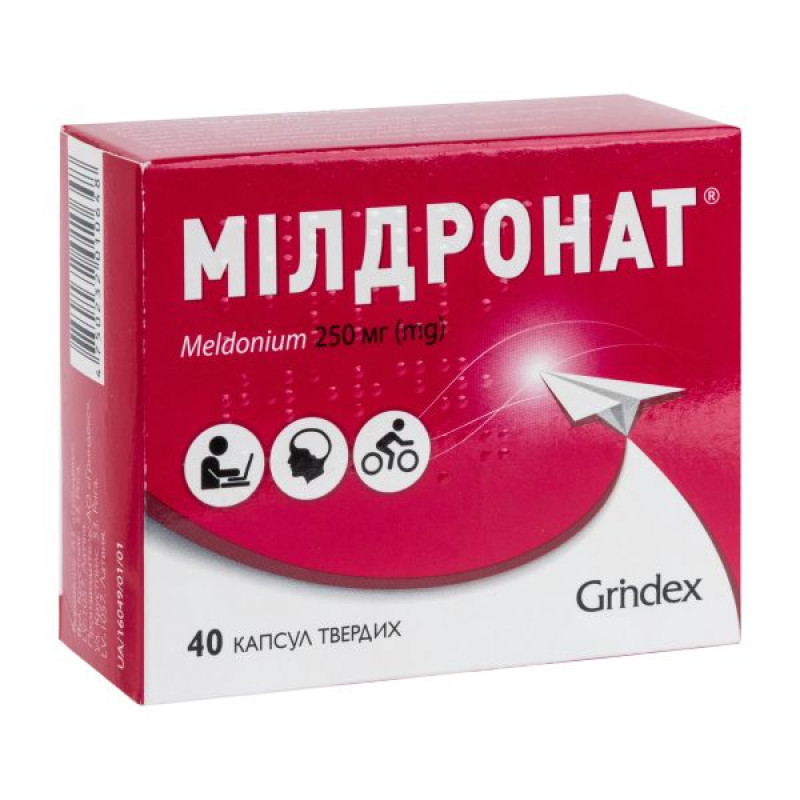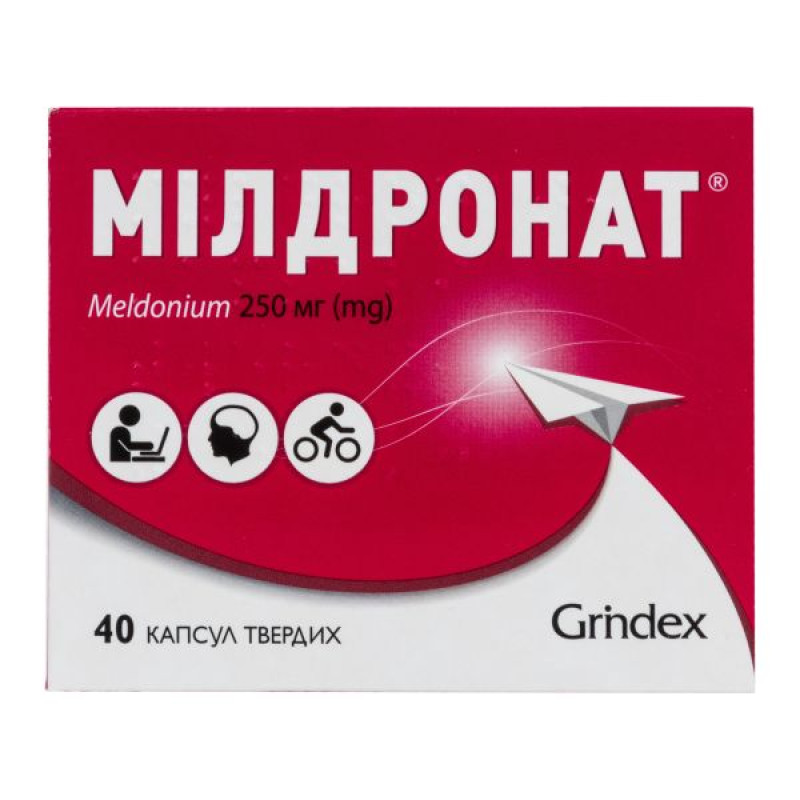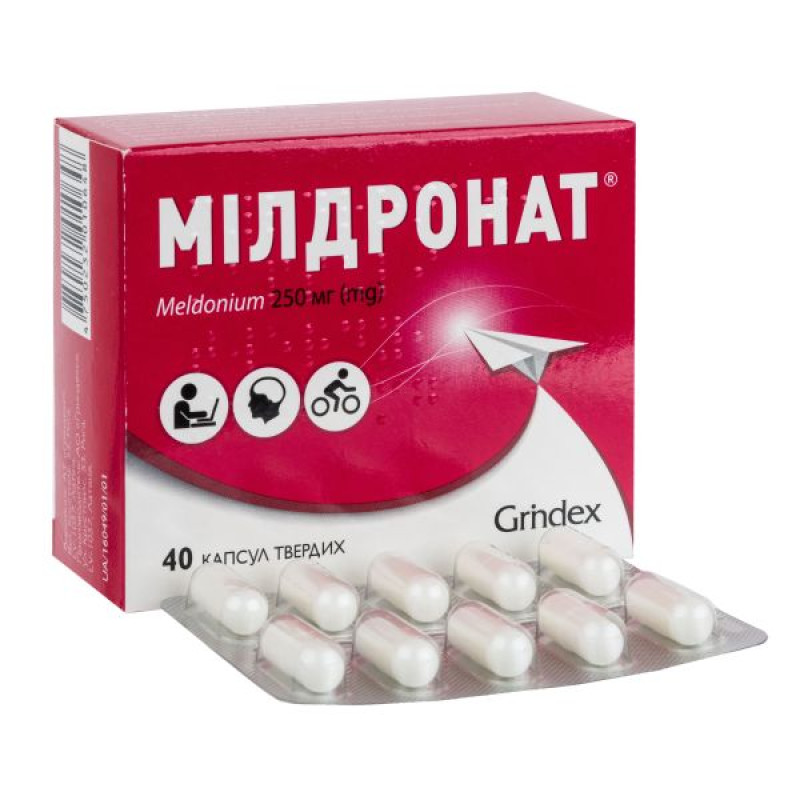Mildronate hard capsules 250 mg blister No. 40

Instructions for use Mildronate hard capsules 250 mg blister No. 40
Composition
active ingredient: meldonium;
1 hard capsule contains 250 mg of meldonium dihydrate;
excipients: potato starch, silicon dioxide, calcium stearate;
capsule (body and cap): titanium dioxide (E 171), gelatin.
Dosage form
The capsules are hard.
Main physicochemical properties: hard gelatin capsules of white color. The contents of the capsules are white crystalline powder with a faint odor. The powder is hygroscopic.
Pharmacotherapeutic group
Other cardiological drugs. ATX code C01E B22.
Pharmacological properties
Pharmacodynamics
Meldonium is a precursor of carnitine, a structural analogue of gamma-butyrobetaine (GBB), in which one carbon atom is replaced by a nitrogen atom. Its effect on the body can be explained in two ways.
Effect on carnitine biosynthesis.
Meldonium, by reversibly inhibiting gamma-butyrobetaine hydroxylase, reduces carnitine biosynthesis and therefore prevents the transport of long-chain fatty acids across cell membranes, thus preventing the accumulation of a strong detergent - activated forms of unoxidized fatty acids - in cells. Thus, damage to cell membranes is prevented.
When carnitine concentration decreases under ischemic conditions, beta-oxidation of fatty acids is inhibited and oxygen consumption in cells is optimized, glucose oxidation is stimulated and the transport of adenosine triphosphate (ATP) from its biosynthesis sites (mitochondria) to its consumption sites (cytosol) is restored. In essence, cells are supplied with nutrients and oxygen, and their consumption is optimized.
In turn, with an increase in the biosynthesis of the carnitine precursor, i.e., GBB, NO synthetase is activated, resulting in improved blood rheological properties and reduced peripheral vascular resistance.
As the concentration of meldonium decreases, carnitine biosynthesis increases again, and the amount of fatty acids in the cells gradually increases.
It is believed that the effectiveness of meldonium is based on increasing tolerance to cellular stress (when changing the amount of fatty acids).
The function of the mediator in the hypothetical GBB-ergic system.
It is hypothesized that there is a neuronal signal transfer system in the body - the GBB-ergic system, which ensures the transmission of nerve impulses between cells. The mediator of this system is the last precursor of carnitine - GBB-ester. As a result of the action of GBB-esterase, the mediator gives an electron to the cell, thus transferring an electrical impulse, and itself is converted into GBB. Then the hydrolyzed form of GBB is actively transported to the liver, kidneys and ovaries, where it is converted into carnitine. In somatic cells, in response to irritation, new GBB molecules are again synthesized, ensuring the propagation of the signal.
When the concentration of carnitine decreases, the synthesis of GBB is stimulated, resulting in an increase in the concentration of GBB ester.
Meldonium, as mentioned earlier, is a structural analogue of GBB and can perform the functions of a “mediator”. In contrast, GBB hydroxylase “does not recognize” meldonium, so the concentration of carnitine does not increase, but decreases. Thus, meldonium, both by replacing the “mediator” and by contributing to the increase in the concentration of GBB, leads to the development of an appropriate reaction in the body. As a result, the overall metabolic activity also increases in other systems, for example, in the central nervous system (CNS).
Effects on the CNS.
Animal experiments have established the antihypoxic effect of meldonium and its effect on cerebral blood circulation. Meldonium optimizes the redistribution of cerebral blood volume in favor of ischemic foci, increases the strength of neurons in conditions of hypoxia.
Meldonium has a stimulating effect on the CNS - increasing motor activity and physical endurance, stimulating behavioral reactions, as well as an anti-stress effect - stimulating the sympathoadrenal system, accumulating catecholamines in the brain and adrenal glands, protecting internal organs from changes caused by stress.
Effectiveness in neurological diseases.
The rehabilitation process of patients with neurological disorders (after suffering from diseases of the blood vessels of the brain, brain surgery, injuries, and tick-borne encephalitis) was studied.
The results of testing the therapeutic activity of meldonium indicate its dose-dependent positive effect on physical endurance and restoration of functional independence during the recovery period.
When analyzing changes in individual and total intellectual functions after using the drug, a positive effect on the recovery process of intellectual functions during the recovery period was established.
It has been established that meldonium improves the convalescent quality of life (mainly by restoring the physical function of the body), in addition, it helps to eliminate mental disorders.
Meldonium has an inherent positive effect on the function of the nervous system - reducing disorders in patients with neurological deficits during the recovery period.
The general neurological condition of patients improves (reduction of damage to the nerves of the brain and reflex pathology, regression of paresis, improvement of coordination of movements and autonomic functions).
Pharmacokinetics
After a single oral administration of meldonium in doses of 25, 50, 100, 200, 400, 800 or 150 mg, the maximum plasma concentration (Cmax) and the area under the time/concentration curve (AUC) increase in proportion to the dose administered. The time to reach the maximum plasma concentration (tmax) is 1–2 hours. With repeated doses, the equilibrium plasma concentration is reached 72–96 hours after the first dose. Meldonium accumulation in the blood plasma is possible. Food slightly delays the absorption of meldonium, without changing the Cmax and AUC values.
Distribution
Meldonium is rapidly distributed from the bloodstream to tissues. Binding to plasma proteins increases with time after dosing. Meldonium and its metabolites partially cross the placental barrier. Animal studies have shown that meldonium is excreted in breast milk.
Biotransformation
In the study of metabolism in experimental animals, it was found that meldonium is mainly metabolized in the liver.
Breeding
Renal excretion is important in the elimination of meldonium and its metabolites from the body. The half-life of meldonium (t1/2) is approximately 4 hours. The half-life varies with repeated doses.
Special patient groups
Elderly patients
Elderly patients with impaired liver or kidney function, in whom bioavailability is increased, should reduce the dose of meldonium.
Kidney dysfunction
Patients with impaired renal function, in whom bioavailability is increased, should reduce the dose of meldonium. Nonclinical studies have shown that when administered orally to animals, meldonium at doses of 20, 100 and 500 mg/kg is of low toxicity and does not affect renal function. There is an interaction between the renal reabsorption of meldonium or its metabolites (e.g. 3-hydroxymeldonium) and carnitine, resulting in an increase in renal clearance of carnitine. There is no direct effect of meldonium, GBB and the combination of meldonium/GBB on the renin-angiotensin-aldosterone system.
Liver dysfunction
Patients with impaired liver function, in whom bioavailability is increased, should reduce the dose of meldonium. During toxicity studies in animals, yellow liver coloration and fat denaturation were observed when meldonium was administered at a dose of more than 100 mg/kg. In histopathological studies in animals, lipid accumulation in liver cells was observed after administration of high doses of meldonium (400 mg/kg and 1600 mg/kg). No changes in liver function parameters were observed in humans after administration of high doses of 400-800 mg. The possible infiltration of fat into liver cells cannot be ruled out.
Children
There is no data on the safety and effectiveness of meldonium in children (under 18 years of age), therefore the use of the drug in this category of patients is contraindicated.
Indication
In complex therapy in the following cases:
reduced working capacity, physical and psycho-emotional overstrain; during the recovery period after cerebrovascular disorders, head injuries and encephalitis.
Contraindication
Hypersensitivity to meldonium and/or any excipient of the drug; increased intracranial pressure (with impaired venous outflow, intracranial tumors); severe hepatic and/or renal failure (there is insufficient data on the safety of use); children under 18 years of age; pregnancy; breastfeeding.
Interaction with other medicinal products and other types of interactions
Meldonium can be used together with long-acting nitrates and other antianginal drugs, cardiac glycosides and diuretics. It can also be combined with anticoagulants, antiplatelet agents, antiarrhythmics and other drugs that improve microcirculation.
Meldonium may enhance the effects of drugs containing glyceryl trinitrate, nifedipine, beta-blockers, other antihypertensive agents and peripheral vasodilators.
With the simultaneous use of meldonium with lisinopril, a positive effect of combination therapy was revealed (vasodilation of the main arteries, improvement of peripheral blood circulation and quality of life, reduction of mental and physical stress).
When meldonium is used in combination with orotic acid to repair damage caused by ischemia/reperfusion, an additional pharmacological effect is observed.
As a result of the simultaneous use of iron and meldonium preparations in patients with iron deficiency anemia, the composition of fatty acids in erythrocytes improved.
Meldonium helps to eliminate pathological changes in the heart caused by azidothymidine (AZT) and indirectly affects oxidative stress reactions caused by AZT, which lead to mitochondrial dysfunction. The use of meldonium in combination with azidothymidine or other drugs for the treatment of AIDS has a positive effect in the treatment of acquired immunodeficiency (AIDS).
Meldonium overdose may enhance cardiotoxicity caused by cyclophosphamide.
Carnitine deficiency resulting from the use of meldonium may enhance cardiotoxicity caused by ifosfamide.
Meldonium has a protective effect against indinavir-induced cardiotoxicity and efavirenz-induced neurotoxicity.
Do not use meldonium capsules together with other drugs containing meldonium, as the risk of adverse reactions increases.
Application features
Patients with a history of mild or moderate hepatic and/or renal impairment should be treated with caution (liver and/or renal function should be monitored).
Ability to influence reaction speed when driving vehicles or other mechanisms
No studies have been conducted to assess the effects on the ability to drive and use machines.
Use during pregnancy or breastfeeding
Pregnancy. Animal studies are insufficient to assess the effects of meldonium on pregnancy, embryonal/fetal development, parturition and postnatal development. The potential risk to humans is unknown, therefore meldonium is contraindicated during pregnancy.
Breastfeeding. Available animal data indicate that meldonium is excreted in human milk. It is not known whether meldonium is excreted in human milk. A risk to the newborn/infants cannot be excluded, therefore meldonium is contraindicated during breast-feeding.
Method of administration and doses
For oral use. Capsules are swallowed with water. The drug is used regardless of meals. Due to the possible stimulating effect, the drug is recommended to be used in the morning.
Adults
The dose is 500 mg per day (2 capsules of 250 mg). The daily dose can be taken all at once or divided into two single doses. The maximum daily dose is 500 mg.
The duration of the treatment course is 4–6 weeks. The treatment course can be repeated 2–3 times a year.
Elderly patients
Elderly patients with impaired liver and/or kidney function may require a reduction in the dose of meldonium.
Patients with renal impairment
Since the drug is excreted from the body by the kidneys, patients with mild to moderate renal impairment should use a lower dose of meldonium.
Patients with liver dysfunction
Patients with mild to moderate liver dysfunction should use a lower dose of meldonium.
Children
There is no data on the safety and effectiveness of meldonium in children (under 18 years of age), therefore the use of meldonium in this category of patients is contraindicated.
Overdose
There have been no reports of overdose with meldonium. The drug is low-toxic and does not cause any dangerous side effects.
Low blood pressure may cause headaches, dizziness, tachycardia, and general weakness. Treatment is symptomatic.
In case of severe overdose, liver and kidney function should be monitored.
Hemodialysis is of no significant importance in case of meldonium overdose due to its pronounced binding to blood proteins.
Adverse reactions
Meldonium is usually well tolerated.
Adverse reactions are classified by system organ class and frequency according to MedDRA: common (≥1/100 to <1/10), rare (≥1/10,000 to <1/1,000).
Side effects observed in clinical trials and in the post-marketing period:
| On the part of the immune system | |
Often Rarely | Allergic reactions* Hypersensitivity, including allergic dermatitis, urticaria, angioedema, anaphylactic reactions up to shock |
| From the psyche | |
| Rarely | Agitation, feelings of fear, intrusive thoughts, sleep disturbances |
| From the nervous system | |
Often Rarely | Headaches * Paresthesia, tremor, hypoesthesia, tinnitus, vertigo, dizziness, gait disturbance, presyncope, syncope |
| From the heart | |
| Rarely | Heart rhythm changes, palpitations, tachycardia/sinus tachycardia, atrial fibrillation, arrhythmia, chest discomfort/chest pain |
| From the circulatory system | |
| Rarely | Increase/decrease in blood pressure, hypertensive crisis, hyperemia, pallor of the skin |
| Respiratory, thoracic and mediastinal disorders | |
Often Rarely | Respiratory tract infections Sore throat, cough, dyspnea, apnea |
| Gastrointestinal tract | |
Often Rarely | Dyspepsia * Dysgeusia (metallic taste in the mouth), loss of appetite, nausea, vomiting, flatulence, diarrhea, abdominal pain, dry mouth or hypersalivation |
| Skin and subcutaneous tissue disorders | |
| Rarely | Rash, generalized/macular/papular rash, pruritus |
| Musculoskeletal system | |
| Rarely | Back pain, muscle weakness, muscle spasms | Renal and urinary system disorders |
| Rarely | Pollakiuria |
| General disorders and administration site conditions | |
| Rarely | General weakness, chills, asthenia, edema, facial edema, leg edema, feeling hot, feeling cold, cold sweat |
| Research | |
Often Rarely | Dyslipidemia, increased C-reactive protein Electrocardiogram (ECG) abnormalities, tachycardia, eosinophilia* |
* Adverse effects observed in previously conducted uncontrolled clinical trials.
Expiration date
4 years.
Do not use after the expiration date.
Storage conditions
Store at a temperature not exceeding 25 °C.
Store in original packaging to protect from moisture.
Keep out of reach of children.
Packaging
10 capsules in a blister; 4 blisters in a cardboard pack.
Vacation category
Without a prescription.
Producer
JSC "Grindex", Latvia.
Location of the manufacturer and its business address
Krustpils Street, 53, Riga, LV-1057, Latvia.
There are no reviews for this product.
There are no reviews for this product, be the first to leave your review.
No questions about this product, be the first and ask your question.





